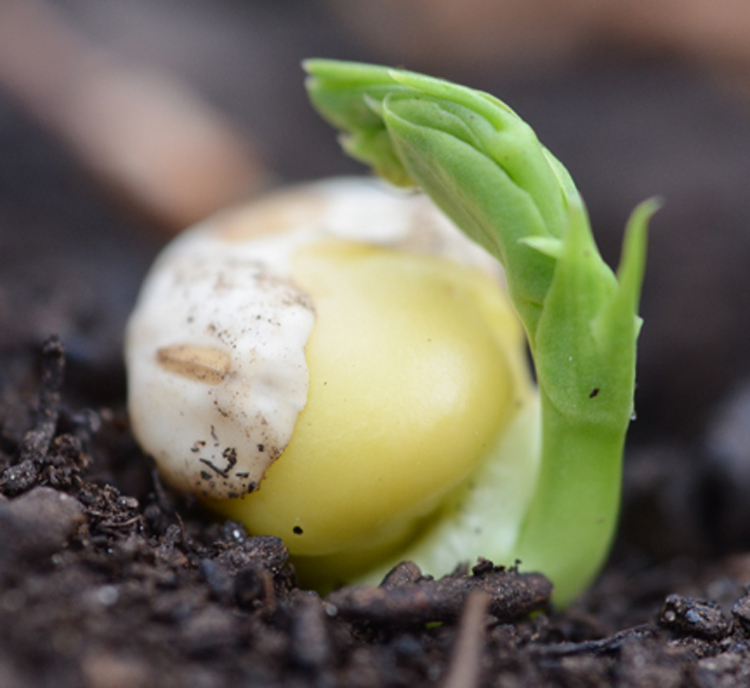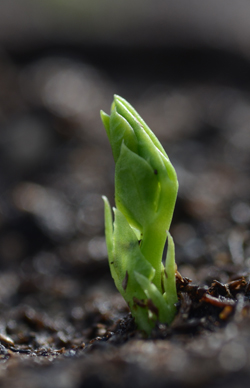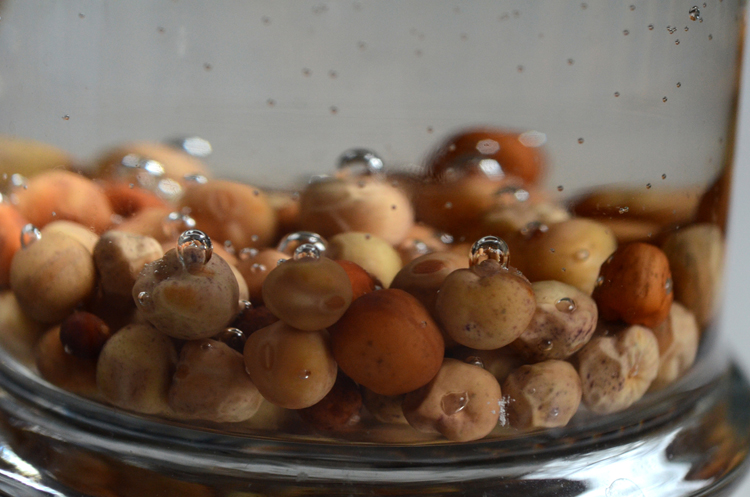St. Patrick’s Day heralds the start of planting season with peas
Posted on: March 15, 2018 | Written By: Doug Oster |
St. Patrick’s Day is the traditional start of the planting season, and it’s something I’ve been doing for decades.
The weather can be problematic though —it could be wet, cold or the soil might be covered in snow. Regardless of what’s going on with the temperature, the first trick to getting those peas to sprout quickly is to soak the seeds in water overnight. It’s amazing to see the transformation the next morning as the tiny hard seeds have swollen to three times their original size with a softened outer coating, ready for germination.

A pea seed sprouts in the early spring after a St.Patrick’s Day sowing. Photos by Doug Oster

A pea seed sprouts in the early spring after a St.Patrick’s Day sowing. Photos by Doug Oster
The garden is usually too wet to turn over. If the soil sticks to the shovel when digging, leave it alone. Working soil that’s too wet will create ugly clumps that persist all season.
When there’s no snow in the garden, a bag of compost from a garden center can be put down over a bed. It’s the perfect place for the seeds as it’s filled with everything they will need when they emerge. Push the seeds about an inch down and cover them by simply dragging your hand across the compost.
The peas can be planted a couple inches apart in straight rows or tossed over the bed to create a carpet of sprouts. Either way, the plants will need some support in the form of a short fence or even sticks pushed into the bed. Peas need cool weather to thrive, but they can be planted well into April if need be. ‘Wando’ is a great variety that can handle warmer temperatures than most. It’s the variety I gave away for the last Seed of the Month Club offering. Most other cultivars will stop producing and give up when warm weather arrives. Even if you don’t get started on the holiday, there are still a few weeks to start the seeds.
I will often cover a bed with some clear plastic skylights that were given to me by a reader or floating row covers. The row covers are made of a lightweight translucent fabric available at garden centers. The skylight or row cover will help warm the soil and speed sprouting.
Another favorite variety is ‘Oregon Sugar Pod II’ snow pea. It’s been part of my spring planting ritual for decades. The plants are stocky, but they need some support. They will produce 4- to 5-inch tender, tasty pods.
I’m trying a new variety this year from John Scheepers Kitchen Garden Seeds. ‘Opal Creek Yellow Snap’ pea has six-foot tall vines. It was the first yellow podded snap pea available to grow, named after an old growth forest in Oregon. White flowers turn into slender, pastel lemon pods. It’s always fun to have something unique added to the spring garden.
What if there’s snow on the ground?
When snow covers the ground and the forecast predicts frigid temperatures, the seeds can be started indoors. Since they resent being transplanted, the peas are sowed in peat pots, fiber containers that rot away in the soil when planted. Fill the pots with a good pre-moistened planting mix. The medium should be moist but not dripping. I’m using CowPots, which are made of cow manure and will release nutrients as they rot away in the soil.
I like to push two seeds into each 4-inch pot; one seed can be planted for smaller pots. Cover the pots with plastic to keep the soil moist and keep the flat in an area that’s 60 degrees or warmer. As soon as they sprout, the pots can be sunk into compost out in the garden.
I have experimented with starting peas in standard flats and then transplanting them into the garden. It sets them back about two weeks, which can be a good thing as it lengthens the harvest. As the first peas reach maturity for picking, the others are just flowering.

Pea seeds are soaked overnight to help them germinate in cool soil when sowed on St. Patrick’s Day.
It’s not just time for peas
Although peas are the traditional first crop planted, gardeners also can think about lots of other cool weather crops for early sowing. Lettuce, radishes, arugula, other greens, beets, carrots, onion sets and spinach are all good choices for planting outdoors in late March. Use the compost technique or wait until the soil is ready. These seeds will sit in the cool soil and sprout when the time is right.
It was my grandmother who told me to start peas on St. Patrick’s Day, and I’m always thrilled to continue the tradition.
Doug Oster is editor of Everybody Gardens, a website operated by 535Media, LLC. Reach him at 412-965-3278 or doster@535mediallc.com. See other stories, videos, blogs, tips and more at everybodygardens.com.
‘Opal Creek Yellow Snap’ peas are available from John Scheepers Kitchen Garden Seeds. 860-567-6086 or kitchengardenseeds.com.